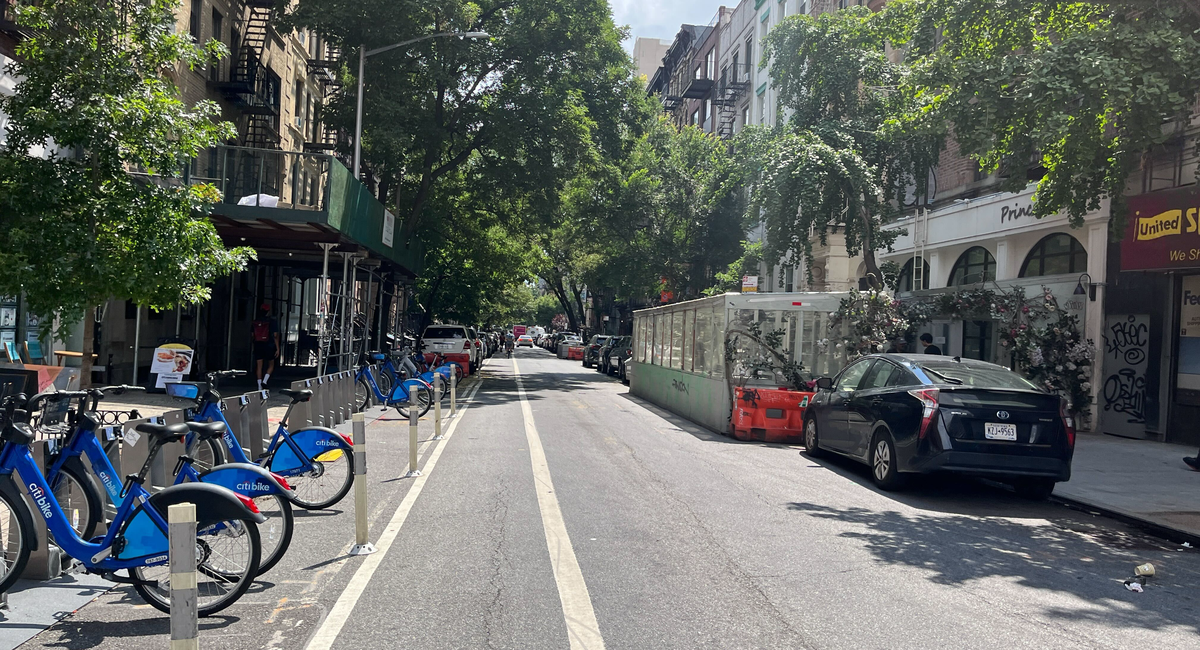The piles of trash bags on New York City’s sidewalks are slated to disappear in the coming years thanks to Mayor Eric Adams’ push to force property owners to put out their garbage in securely lidded bins.
But there’s hardly any room for bins on a block of East 10th Street whose bustling sidewalks are packed with row houses and restaurants. And with parking on both sides of the narrow, one-way street, there’s also little space to install the shared European-style dumpsters being piloted in West Harlem.
A 2023 sanitation department report about the challenges of containerization singled out the block between First and Second avenues as one where on-street dumpsters “are not viable” because they’d need to occupy 25% of the curb space to handle all the trash discarded by its 970 residents.
Corridors like this pose a major challenge to Adams’ “trash revolution,” which requires building owners to use not-so-novel garbage containers to eliminate mountains of trash bags from the city’s curbs. The bin mandate is already in effect for businesses. Residential properties with fewer than 10 units must start abiding by the rule in November.
Larry DeBono, a superintendent of a 31-unit building on the East Village block, isn’t yet required to put out his trash in bins. But he said he’s already doing so because he’s struggling with rules that prohibit leaving trash bags on the curb until the night they’re picked up. With limited storage space, he’s resorted to keeping his building’s trash in six cans set inside its vestibule.
With no room for trash bins on the sidewalk, one East 10th Street super is keeping his inside the building’s vestibule.
Liam Quigley/Gothamist
Sanitation officials said they’ll eventually install shared, dumpster-like containers in parking spaces for trash from large buildings like his, but do not yet have a timeline for the rollout. Large properties with 10 or more units will eventually be required to either use the planned streets containers or a city-issued wheeled bin for their garbage.
But for now, DeBono said he has no other option than to keep the stinky bins at the entrance, even if it isn’t ideal for his tenants.
“If I keep the garbage on the side, even if it’s tied, they give us a violation… I don’t have nowhere to store it at the moment,” said DeBono. “It’s not easy, man.”
Since the start of 2023, DeBono’s landlord has been fined more than $3,000 for litter on the sidewalk.
But DeBono’s block isn’t the only one facing the challenge of limited space for shared containers. Last year’s report said roughly 11% of the city’s streets face similar constraints — but sanitation officials said that figure could be reduced to 4% thanks to changes to the program, including scaling back a plan to force New Yorkers to put out their recycling in bins.
Goodman said shared containers set on the street have been a success in West Harlem. But before the city deploys the dumpsters across the five boroughs, it plans to conduct an environmental study on the initiative, which could drag on for months or years.
“The goal is clear: Containerize all the trash,” said sanitation department spokesperson Joshua Goodman. He said that on blocks like East 10th Street, the department is considering installing street containers assigned to specific buildings, rather than communal dumpsters.
“That solves the density challenge,” said Goodman. “And it solves the risk of, ‘Whose responsibility is this container?”
East 10th Street super Larry DeBono fears he may be left behind by the “trash revolution.”
Liam Quigley/Gothamist
If DeBono’s block doesn’t get the shared street containers, as last year’s report suggests, all the property owners there would eventually need to put out their trash in official wheeled bins issued by the sanitation department. Those bins are 45 gallons — and last year’s consultant report notes the block produces up 66,000 gallons of waste per week.
“You need how many containers?” said DeBono. “You need a dumpster. But I don’t know how this is gonna work.”
Goodman said supers in West Harlem have been happy with the on-street containers because they help buildings free up space that was previously used for trash storage.
But Daniel Garcia, another super on DeBono’s block, said it’s hard to compare his street to the wider ones in West Harlem where the shared dumpsters have been installed.
The 10th Street block is in one of the city’s “rat mitigation zones.” Although Garcia said he shares the city’s goal of reducing the area’s pest population, he said the bins themselves can also attract rodents.
“Five rats were in one bin,” he recalled. “I had to literally kill them all. I had a stick I used to actually kill them.”
